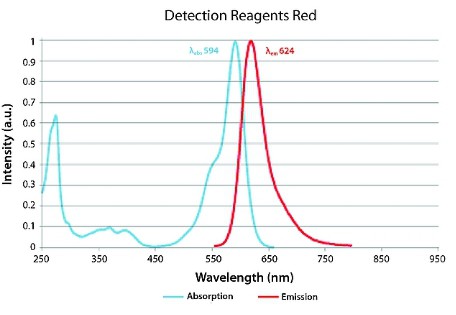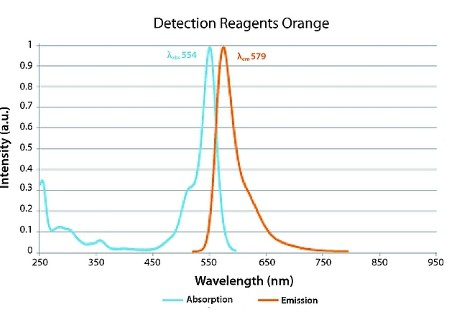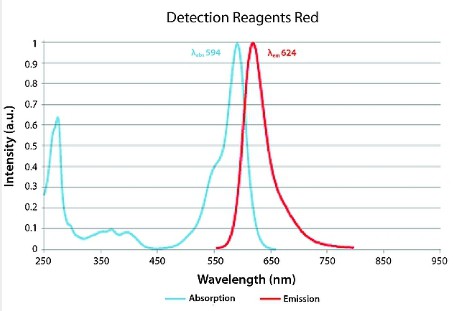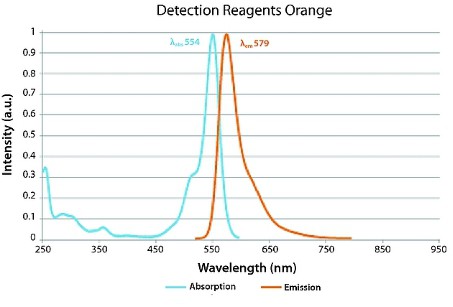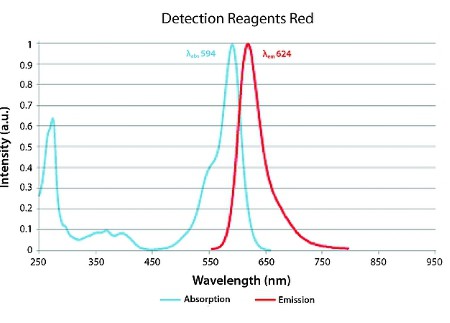
Duolink™ In Situ Probemaker PLUS
To perform a complete Duolink™ PLA in situ experiment you will need two primary antibodies (PLA, IHC, ICC or IF validated) that recognize two target epitopes. Other necessary reagents include a pair of PLA probes from different
species (one PLUS and one MINUS), detection reagents, wash buffers, and mounting medium. Note that the primary antibodies must come from the same species as the Duolink™ PLA probes. Analysis is carried out using standard immunofluorescence
assay equipment.HRP is also available for brightfield detection.
Specificity
Duolink™ In Situ Probemaker extends your possibilities even further by allowing you to create your own PLA probes to meet specific assay requirements.
• Study
homodimers
• Study protein-protein interactions with two primary antibodies derived from the same species
• Study protein-protein interactions with primary antibodies from any species
Using Duolink™ In Situ Probemaker
PLUS and MINUS, you simply conjugate the PLUS and MINUS oligo arms directly to your antibodies in a quick and convenient procedure. As well as providing unique capabilities, this also means there is no longer any limitation as to which species your
primary antibodies have to be derived from in order perform a Duolink™ In Situ assay.
Application Note
The antibody to be conjugated must have a concentration of 1 mg/ml. Do not use volumes larger than 20 ml for conjugation.
The antibody must be in an amine free buffer, ideally PBS. The buffer should be carrier free but may contain up to 0.1% BSA, 5% trehalose, and 0.02% sodium azide.
• Study homodimers by using one monoclonal antibody split into two halves. Label
one with the PLUS oligo and the other with the MINUS oligo.
• Use antibodies from same species: study protein-protein interactions, protein modifications, or single proteins, using two primary antibodies derived from the same species. Label
one of the antibodies with the PLUS oligo and the other with the MINUS oligo
• Use antibodies from any species: study protein-protein interactions, protein modifications, or single proteins, using one or both primary antibodies derived from
species other than mouse, rabbit or goat. Label one of your secondary antibodies with the PLUS oligo and the other with the MINUS oligo. Or, combine one labeled secondary antibody with a standard secondary Duolink™In Situ PLA probe.
Test
your primary antibodies (IgG-class, mono- or polyclonal) in a standard immunofluorescence (IF), immunohistochemistry (IHC) or immunocytochemistry (ICC) assay to determine the optimal fixation, blocking, and titer conditions. Duolink™ in situ reagents are suitable for use on fixed cells, cytospin cells, cells grown on slide, formalin-fixed, paraffin embedded (FFPE), or tissue (fresh or frozen). No minimum number of cells is required.
Let us do the work for you, learn more about
our Custom Service Program to accelerate your Duolink™ projects
View full Duolink™ product list
• No overexpression or genetic manipulation required
• High specificity (fewer false positives)
• Single molecule sensitivity due to rolling circle amplification
• Relative quantification possible
• No special
equipment needed
• Quicker and simpler than FRET
• Increased accuracy compared to co-IP
• Publication-ready results
This product is comprised of the following:
• Duolink™ In Situ oligonucleotide PLUS – one vial with lyophilized activated PLUS oligonucleotide for one conjugation of 20 μg antibody
• Conjugation buffer – buffer for
conjugation reaction
• Stop reagent – stops conjugation reaction
• Storage solution – buffer for preserving prepared PLA probe (conjugated antibody)
• 20x Assay reagent – reagent to be added to experimenter optimized antibody
diluent
• Blocking solution – blocks sample prior to staining with Duolink™ In Situ
• PLA probe diluent – buffer for diluting PLA probe (conjugated antibody) to final assay concentration
See datasheet for more
information.
Duolink™proximity ligation assay(PLA®) allows for endogenous detection of protein interactions, post translational modifications, and protein expression levels at the single molecule level in fixed cells and tissue samples.
Follow
the Duolink™In Situ Probemaker Protocol to use the Duolink™In Situ Probemaker PLUS and MINUS.This product can be applied to both the Duolink™ In Situ Fluorescence Protocol and the Duolink™ In Situ Brightfield Protocol depending on the detection reagents used.For more information, see Create Your Own PLA® Probes.
Visit our Duolink™ PLA Resource Center for information on how to run a Duolink™ experiment, applications,
troubleshooting, and more.
Duolink is a trademark of Sigma-Aldrich Co. LLC
PLA is a registered trademark of Sigma-Aldrich Co. LLC
